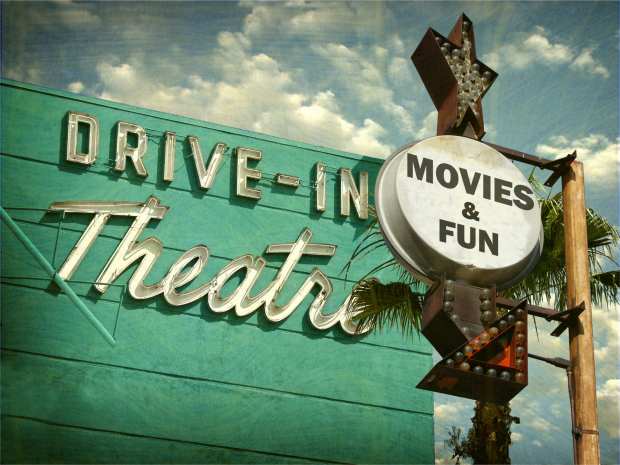Drive-Ins, Straight To Streaming And Keeping Cinema Alive In The Age Of Coronavirus

While the last few weeks haven’t been good news for anyone not selling bleach, toilet paper, N95 masks or canned soup, the entertainment industry has been hit hard as television shows and films have fallen out of production, theatrical releases have been delayed and movie theaters nationwide have shut down. Last week, the nation’s two largest theater chains, AMC and Regal Cinemas, both announced they were shutting their doors as part of efforts to limit the spread of COVID-19 in the U.S. — for the next 12 weeks and indefinitely respectively.
The situation is severe enough that the National Association of Theatre Owners (NATO) is asking Congress to provide relief measures for its 150,000 employees.
“The business model of the movie theater industry is uniquely vulnerable in the present crisis,” NATO noted in a statement last week.
But while theaters have shut down nationwide, Americans’ enthusiasm for going to the movies seems relatively undimmed — even if one has to use the phrase “going” loosely. While some releases have been delayed — notably Disney’s “Mulan” and the ninth installment in the “Fast & Furious” franchise — many others have simply been sent straight to the stream. In some cases they can be rented, in some they are heading early all-inclusive services like Disney+ or Netflix. Some are a hybrid — Disney’s “Onward” has been released for paid download and will be moving to Disney+ for members as of April 3.
And while it has been widely speculated that the availability of brand new, or at least newish releases, may be leading to a future when movies are all dual-released to streaming services and theaters at the same time, another less noted and perhaps more surprising emerging trend makes us wonder about that assumption. Because while the surge in home streaming certainly indicates consumers are willing to watch at home, another unexpected surge popping up in pockets nationwide indicates that customers don’t want to just see new releases. They actually want to go to them.
At a drive-in theater if necessary. Because that is what’s open right now.
The box office take for all U.S. titles last weekend was $260,000 — a roughly 98 percent decline from this time a year ago. All in, according to recent estimates, there are fewer than 500 movie theaters open for business, and roughly 60 percent of them are drive-ins, which have remained mostly exempt from local bans on opening affecting movie theaters.
Back to the Drive-In
Though once popular in the United States — in the 1950s and ’60s there were around 4,000 drive-ins operating — their popularity dropped steadily from the 1970s though the early 2000s such that as of 2020 there are only 305 drive-in theaters operating in the U.S., mostly in Pennsylvania, Ohio and New York.
And, as reports nationwide indicate, they are, after a roughly 50-year hiatus, doing a booming business.
“Obviously this isn’t the way you’d want it to occur, but I’m excited for the idea that there may be a new generation of people that will get to experience going to a drive-in theater and — I was going to say catch the bug,” Andrew Thomas, the owner of Showboat Drive-In Theater in Hockley, Texas told the Associated Press. “Maybe some other turn of phrase.”
And Thomas is not the only drive-in owner experiencing an unexpectedly good run of late. Beau Bianchi, owner-operator of the two-screen Paramount Drive-In, told the L.A. Times that ticket sales last week were “at least double” what they typically would be.
“It has been a welcome relief for families and adults looking for a little getaway from the house,” Bianchi said. “We’ve been trying to let people know that we have a safe environment and [offer] a little escape.”
Some drive-ins have notably closed or delayed season openings, and according to John Vincent, president of the United Drive-In Theatre Owners Association, a nonprofit industry advocacy group, the drive-ins doing well are in areas not as yet heavily affected by the outbreak. Closures could and will likely expand as the coronavirus pandemic continues.
However, the relieved and enraptured tone of drive-in visitors from the last few days indicate that our viewing habits may change in a post-COVID-19 world, though perhaps not quite as drastically as some have forecast. As it turns out, people really like going to the movies — the operative word in that sentence being “going.”
“So, Day Two of homeschool, we are all cooped up in the house, and this was a way to go out and still be distant from other people but not at our house,” parent Brenna Coogle told the L.A. Times of her recent sojourn to a drive-in to see a double-feature with her 9-year-old son.
And that is just two days. We imagine after the weeks or even months experts forecast this stay-in period will last, that feeling of needing to go out might be somewhat more acute. The wait times between theatrical releases may be forever shortened, streaming will almost certainly be a strengthened competitor to the physical experience as a result of the next several weeks.
But consumers don’t just want to see a movie, they also still want to go to a movie, together if possible, with popcorn made by someone else.
